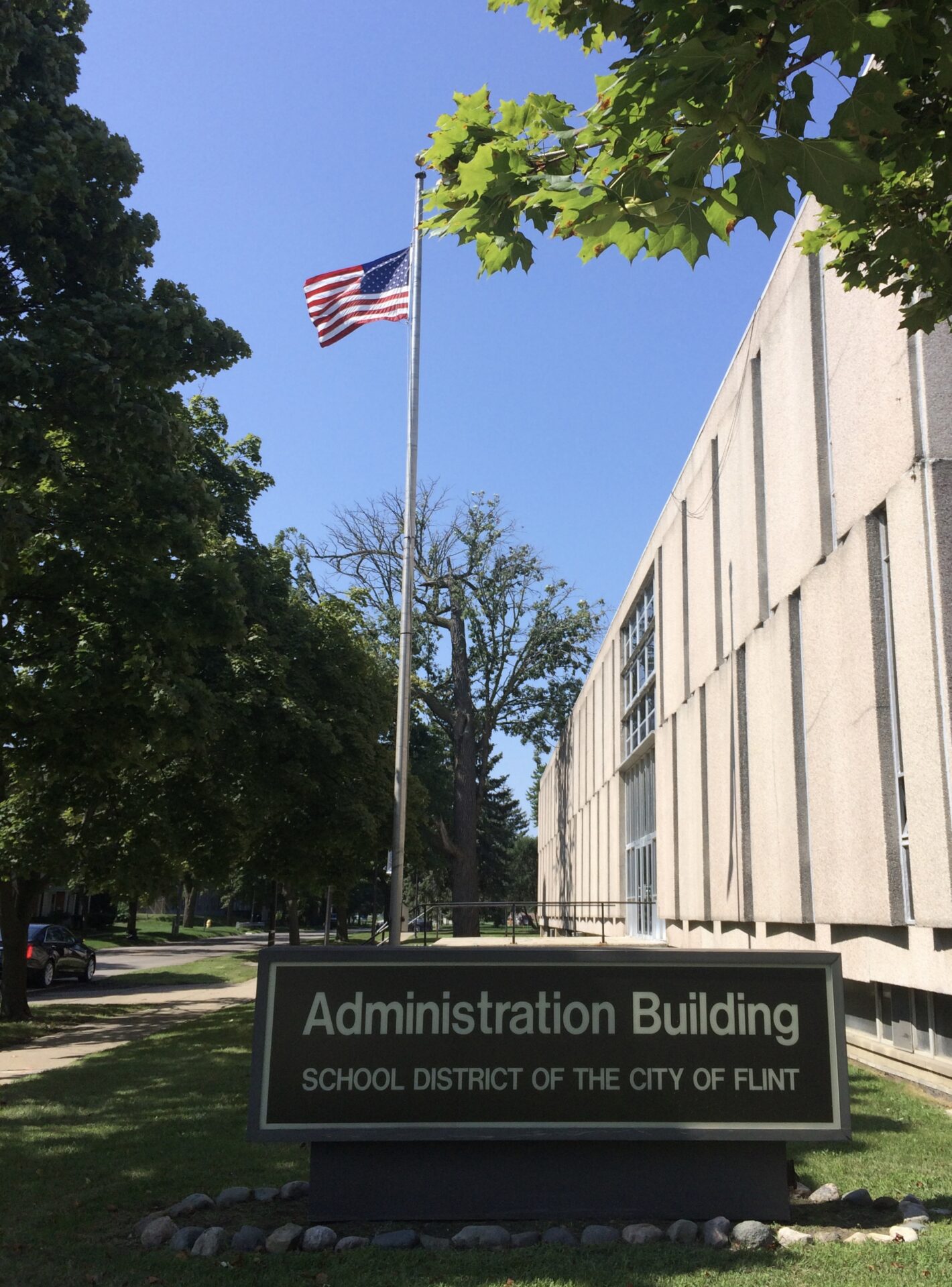By Jan Worth-Nelson and Harold C. Ford
Behind the scenes as Flint students and teachers go back to school this fall, a make-or-break drama is underway that significantly affects the future of the Flint Community Schools, its 12 schools and 4,600 students.
The district, which landed last year in the bottom five percent of districts statewide, has been placed in a category of “chronically failing schools,” and given 36 months by the State of Michigan to pull itself up under state oversight.
If the efforts fail, according to a “partnership agreement” signed in July, the district could face three possible consequences: being absorbed by another district, being reconstituted, or being shut down.
 The district’s motto, included with its logo, is ‘Expect More. Achieve More,” in four words, a summary of what the state expects. To do this within the next 36 months, the plan for the district’s rehabilitation has three targets:
The district’s motto, included with its logo, is ‘Expect More. Achieve More,” in four words, a summary of what the state expects. To do this within the next 36 months, the plan for the district’s rehabilitation has three targets:
- increase attendance of students to 90 percent.
- reduce out-of-school suspension by 10 percent, by implementing the “Positive Behavior Interventions and Support” (PBIS) system.
- Increase course/state exam performance by at least 10 percent by strengthening and implementing K-12 math and literacy curriculum and effective use of instructional practices.
The agreement was forged between FCS and the Michigan Department of Education (MDE), the State School Reform/Redesign Officer (SRO) and the Genesee Intermediate School District (GISD).
In addition, a handful of powerful local stakeholders came to the table to support the district’s efforts and co-sign the agreement.

Flint Community Schools headquarters at the corner of Kearsley and Crapo (Photo by Jan Worth-Nelson)
While it was imposed from the state, the partnership agreement, according to state officials, is designed to maximize and retain local control. It is thus unlike the emergency manager approach applied elsewhere, including the notorious EM years between the state and the City of Flint, an arrangement implicated in the water crisis. According to the agreement, the MDE, the GISD, and the FCS and its board are the “primary decision-making bodies.” But the other community players were invited in and agreed to detailed supporting roles
The full list of signing partners are the MDE superintendent; the MDE State School Reform Officer; the Flint Community Schools superintendent; the president of the FCS board of education; the superintendent of the Genesee Intermediate School District (GISD); the C.S. Mott Foundation; Michigan State University; the CRIM Fitness Foundation; and the Concerned Pastors for Social Action.
New superintendent weighs in
“The goals and benchmarks outlined in the Partnership Agreement outline critical identifiers of success in our district,” the FCS’s newest superintendent, Derrick Lopez asserted in response to a series of questions from EVM. “I will work tirelessly—along with the Board of Education, district administration, teachers and staff, and essential community partners—to not only meet, but exceed the measures set out by the agreement.”
Addressing the “whole child”
“The foundation for meeting those goals, however, must rest in our identifying with particularity the ancillary challenges that the students and families of the Flint community face every day,” Lopez continued. “These issues substantively impact student attendance, behavior, and classroom achievement, which are the ‘ABC’s’of the Agreement. Accordingly, we have to utilize our existing resources within a systemic framework that seeks to impact the ‘whole’ child, and not simply achievement scores. That is the work that must be taken to achieve the targets outlined in the Partnership Agreement.”
In particular, Lopez said, addressing school attendance will be crucial, and suggested the broad community engagement components of the agreement will be needed.
“Students can’t learn if they’re not in the classroom, and attendance will be a critical measure to increase student achievement,” he said. ”
“Attendance for students in grades K-6 is often an indication that external factors may exist and we are committed to working closely with parents to address such factors and ensure students are in school all day, every day. We must address those barriers that are relegating school attendance for their children to secondary or even third order importance,” Lopez said.
“For our students at the secondary school level, they are making choices often that are against their interest. It is our hope to engage in a dialogue about the root causes of school absences, address those directly without speculation, and develop an action plan,” he said. “The district, in partnership with community organizations, is committed to addressing all of the factors that impact attendance, and we believe that while the goal is ambitious, we can reach that target for the future of our students and the economic outlook for this region.”
Decades of trouble
For decades the Flint school district has been plagued by funding decreases, enrollment declines, school closures and decimated test scores. Of 15,000 school-age children living in the district, only about 4,600 are enrolled in the FCS.
That is compared to almost 48,000 in the public schools in the system’s heyday in 1968.
The district has gone from 54 school buildings to 12, many of which are in deteriorating physical condition.
Broad-based community partnerships
According to the agreement,
The Mott Foundation will provide a broader community focus, continuing to consider support for the identified needs of FCS and its stakeholders including Michigan State University, the Crim Fitness Foundation, and the Genesee Area Focus Fund (YouthQuest)
Michigan State University will provide professional development and technical support.
The Crim Fitness Foundation will support implementation and coordination of community school strategies.
The Concerned Pastors for Social Action will promote parent engagement and community involvement.
The form and practice of the agreement is authorized under a state law; of the state’s 587 school districts, Flint was among 21 targeted for intervention and accountability measures.
The district was notified in May of the state intervention, and in a series of meetings since, the district, along with its community stakeholder/partners, developed a set of goals and strategies. The FCS was given 90 days to consider and sign off on the plan.
The full text of the agreement is available here.
18- and 36-month benchmarks built in
According to the 19-page document, the purpose of the agreement is “to work collaboratively in setting 18-month benchmarks and 36-month outcome goals with intent to significantly increase student achievement… and to determine the next level of accountability should this agreement not be…met by the district. “
The agreement calls for formation of an Advisory Council made up of all the signing parties and including FCS students. One role of the council is to produce a plan for the district that would stay in place during leadership changes.
The district has had a series of superintendents in the past decade; the last superintendent, Bilal Tawwab, was terminated abruptly last spring. An interim superintendent, Gregory Weatherspoon, was the signatory for the district but Lopez will lead the district’s response.
The district’s 12 remaining schools are:
— Accelerated Learning Academy/Northwestern
— Brownell STEM Academy
— Doyle Ryder
— Durant-Tuuri-Mott
— Eisenhower
— Freeman
— Holmes STEM Academy
— Neithercut
— Pierce
— Potter
— Scott
— Southwestern Classical Academy, the only remaining high school
Included in the agreement was the district’s projected 2019 budget of $58 million described in the document as for “planning purposes only.” That includes $17.6 million for salaries; $12.6 million for benefits; $17.6 million for purchased services; $1.6 million for professional learning; $1.3 million for supplies and materials; and $8.8 million for other expenditures.
Mott Foundation perspectives
Asked if she was optimistic or pessimistic about the district’s chances of fulfilling the partnership agreement, Mott Foundation Flint Area Program Director Kimberly Roberson said she is hopeful.
“I do believe, based on our work with them and the types of supports they’ve asked from us, that they are focused on those three things [attendance, suspensions, test scores], and that they chose well based on where they believe they have both the need and where they have the capacity to move the needle,” she said.
The three main goals “are appropriate places for the system to focus and things that matter to the students and to their outcomes,” she said.
In an interview with EVM following the signing of the agreement, Roberson and Jennifer Liversedge, Mott Foundation Flint area assistant to the chairman/CEO and program officer for the Foundation’s Flint Area team, noted the Foundation has contributed $54 million in support of the Flint Community Schools over the past five years.
That included technical support from the Rehmann accounting group for forensic accounting and helping the district restructure a $21 million deficit into a long-term financed debt.
The Foundation also has covered the cost of all textbooks for K-12 students in all core subjects, and is funding the revived community education initiative, run by the Crim Fitness Foundation, in all 12 schools. Repairs and improvements at Southwestern Academy also have been covered by Foundation money.
Roberson reiterated the Foundation’s primary contribution is financial—“that is what we do” she said—but it also aims to put district officials together with “thought leaders” to help local educators proceed with best available strategies.
“We’ve been involved with the district for some time, of course, with our grant support. We were in ongoing conversations with them already, and we were aware when this emerged,” Roberson said. “It wasn’t news to them that they had challenges…there were lots of thing they wanted stronger proficiency on even if the state hadn’t put them into the partnership list.”
In the state’s notice last spring, four of the district’s schools were identified specifically as needing intervention: the Accelerated Learning Academy, Holmes STEM Academy, Northwestern High School (which closed at the end of the 2017-2018 school year) and Potter School. But district officials chose to include all 12 schools in the partnership agreement.
This article was updated Aug. 27 to include comments from FCS Superintendent Derrick Lopez.
EVM Editor Jan Worth-Nelson can be reached at janworth1118@gmail.com. EVM staff writer Harold C. Ford can be reached at hcford1185@gmail.com.


You must be logged in to post a comment.